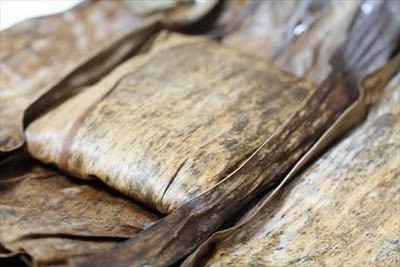 Life & Style
Life & Style

Bảo Hiên cake was also considered bánh tiến (cake to offer the King) and became famous nation-wide. In the 1990s the cake won the first national gold medal at the Giảng Võ Exhibition Fair in Hà Nội, for its aroma and excellent quality.
 |
| Collective effort: A group of people make the Ninh Giang bánh gai. |
Viet Nam Newsby Thanh Hà
I have many relatives living abroad, in countries like the US, Denmark, Norway and so on.
It is safe to say that all of them, without exception, miss the food they used to have at home, and are prone to request some to be sent from here, once in every while.
From what I can see, among the items most in demand among the Vietnamese diaspora in all corners of the world are specialties from Hải Dương Province: the bánh đậu xanh (green bean cake) Rồng Vàng Bảo Hiên and the bánh gai (glutinous rice cake dyed black with a concoction of pinnate leaves ) Ninh Giang.
These snacks are made elsewhere, too, but people generally swear by the ones that are made in Hải Dương.
Trần Lệ Mẫn, a relative living in Denmark, enjoys having the bánh đậu xanh with (green) tea, a popular combination. He thinks the fatty sweetness of the cake goes along well with the acrid, bitter flavor of the tea.
“I like the cake a lot because it is not so sweet and melts easily in my mouth. When I have it, its flavour and fragrance takes me to Việt Nam, my homeland,” Mẫn said.
 |
| Brand value: Bảo Hiên Rồng Vang is the most popular green bean cake maker in Hải Dương Province. |
Hiên took his green beans recipe to Hải Dương in 1922, and opened the first shop in the province. After he died, his daughter Nguyễn Thị Nhung took over the establishment, and it flourishes to this day.
Nhung employs 30 workers to produce 300-400 kg of cake daily. Early in the morning, many wholesale traders arrive to pick up the cakes, note down how many they take in a book and return in the evening to pay for them.
In a competitive market, Nhung takes particular care to retain her customers’ trust by being ready to destroy any cake or batch of cakes that do not meet quality standards.
Nhung’s daughter Phùng Thanh Nhã said her mother imports quality sugar from Tuy Hòa in the south by train, green beans from Kiến An by boat and pork fat from Lục Nam.
The green beans are cooked with several ingredients including a vanilla essence to make the cake, Nhã said, adding that their shop was busy and crowded from early morning until late in the night.
In 1932, the Bảo Hiên cake joined the Sài Gòn Food Fest. The cake was highly appreciated by King Bảo Đại, who granted it a certificate with a dragon image on it. The dragon has been a Bảo Hiên trademark since then.
Bảo Hiên cake was also considered bánh tiến (cake to offer the King) and became famous nation-wide. In the 1990s the cake won the first national gold medal at the Giảng Võ Exhibition Fair in Hà Nội, for its aroma and excellent quality.
Herbalist Đặng Văn Tuất of the Hải Dương Centre of Traditional Medicine says the cake is very good for children and the elderly. “It helps reduce weight gain, cholesterol and triglycerides as well as prevent arteritis among the elderly. It cools body heat and reduces toxins for children during the summer.”
In the old days, only the really well off people could enjoy the cake, but that has changed since.
 |
| Leafy flavour: Bánh gai wrapped up in dried banana leaves carry a different taste. |
Bánh gai Ninh Giang
A very different kind of green bean cake from the one discussed above, the making of bánh gai (glutinous rice cake) is a bit complicated, but for Mơ, every effort is worth it because it has a taste “no words can express”.
The legend associated with this snack is that a poor couple, hungry because the harvest was bad that year, went looking for wild leaves they could eat. They found one plant and brought it home, and decided to cook its leaves with rice. They had made a good choice! An appetizing aroma came from the rice pot, and the rice itself was very soft and tasty.
So the couple picked more leaves, dried and saved them to cook with rice. Then they started mixing the leaves with glutinous rice to make cakes that could be eaten for a longer time. Later on, their descendants began making the cake by wrapping it with dried banana leaves and using other ingredients like green beans as a stuffing.
Ninh Giang people call this cake bánh lá gai.
Mơ says her mother was the original bánh gai maker in Ninh Giang some 50 years ago. To make a quality cake, her mother had to order nếp cái hoa vàng (glutinous rice) from Kinh Môn District, well known nationwide for the quality and taste of its rice. The molasses used for the cake had to be very sweet and the pinnate leaves should also be sticky to be soft and delicious.
“She asked me to clean the leaves before cooking them till they were well stewed. Then they were washed again and mixed with molasses for 2-3 days before being ground very carefully,” said Mơ.
Mơ said her mother had to make the cake’s stuffing very carefully, too. She used meat from the neck of pigs and cut them into pieces and mixed it with molasses to reduce its greasiness, while retaining its crispiness. Lotus seeds had to be cooked until they were soft, but not broken, and retained their natural flavour.
The outer layer of the cake was made with glutinous rice powder that was mixed with the stewed pinnate leaves, whereupon it turned black. After this layer was stuffed, the whole cake was wrapped in dry banana leaves and steamed.
 |
| Medicinal: Pinnate leaves are not only used to make bánh gai but also to treat several ailments. — Photos dulichhaiduong.com |
Bánh gai makers in Ninh Giang steamed the cake for two hours.
Many customers have remarked that they enjoy Mơ’s cake the most because of its lightness. It is not too sweet or greasy or fatty.
In the past, the cake was only made for special occasions, like Tết or death anniversaries. “And for such such occasions, people had to place an order several months earlier. Very few ordinary people could enjoy the cake,” Mơ recalled.
Bánh gai is very popular now, and many farming households know how to make it. The cake is not just available in Ninh Giang now. It follows students going abroad, as they take gifts for their friends.
Despite her age, Mơ tries to push descendants who make bánh gai to keep its traditional flavor and taste. — VNS




